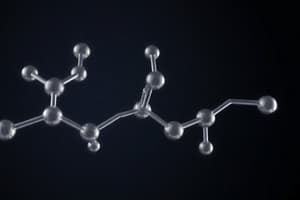Podcast
Questions and Answers
What is the effect of a competitive inhibitor on the apparent Km of an enzyme?
What is the effect of a competitive inhibitor on the apparent Km of an enzyme?
- It is increased (correct)
- It is decreased
- It is unchanged
- It becomes zero
What happens to the reaction velocity when the concentration of substrate is increased in the presence of a competitive inhibitor?
What happens to the reaction velocity when the concentration of substrate is increased in the presence of a competitive inhibitor?
- It decreases
- It reaches Vmax (correct)
- It becomes zero
- It remains unaffected
What is the effect of non-competitive inhibitors on the binding of substrate to enzyme?
What is the effect of non-competitive inhibitors on the binding of substrate to enzyme?
- They bind to the active site of the enzyme
- They have no effect on the binding of substrate to enzyme (correct)
- They increase the binding of substrate to enzyme
- They decrease the binding of substrate to enzyme
What is the point of intersection between the plots of inhibited and uninhibited reactions in a Lineweaver-Burk plot?
What is the point of intersection between the plots of inhibited and uninhibited reactions in a Lineweaver-Burk plot?
What is the result of increasing the substrate concentration in the presence of uncompetitive inhibitors?
What is the result of increasing the substrate concentration in the presence of uncompetitive inhibitors?
What is a potential limitation of enzyme activity measurements?
What is a potential limitation of enzyme activity measurements?
What is the purpose of maintaining a constant pH during enzyme concentration measurements?
What is the purpose of maintaining a constant pH during enzyme concentration measurements?
What is the effect of non-competitive inhibitors on Vmax?
What is the effect of non-competitive inhibitors on Vmax?
What is the effect of non-competitive inhibitors on Km?
What is the effect of non-competitive inhibitors on Km?
What is the principle of the fixed-time assay method?
What is the principle of the fixed-time assay method?
How do uncompetitive inhibitors differ from competitive inhibitors?
How do uncompetitive inhibitors differ from competitive inhibitors?
What is the advantage of continuous-monitoring or kinetic assays?
What is the advantage of continuous-monitoring or kinetic assays?
What is the effect of increasing substrate concentration on competitive inhibition?
What is the effect of increasing substrate concentration on competitive inhibition?
What type of bond is formed between a reversible inhibitor and an enzyme?
What type of bond is formed between a reversible inhibitor and an enzyme?
What happens when the concentration of substrate is significantly higher than the concentration of a competitive inhibitor?
What happens when the concentration of substrate is significantly higher than the concentration of a competitive inhibitor?
What is the characteristic of non-competitive inhibitors?
What is the characteristic of non-competitive inhibitors?
What is the effect of increasing substrate concentration on uncompetitive inhibition?
What is the effect of increasing substrate concentration on uncompetitive inhibition?
What is the characteristic of mixed inhibitors?
What is the characteristic of mixed inhibitors?
Flashcards are hidden until you start studying



